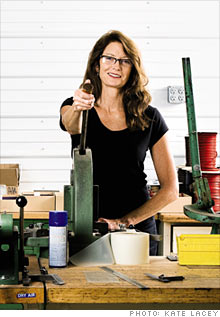After fire, a business is reborn
A fire destroyed my manufacturing firm - and ignited my entrepreneurial spirit.
 |
| Wendy Stevens, in her rebuilt studio |
 |
| Stevens's studio was a total wipeout. |
BOYERTOWN, PA. (Fortune Small Business) -- On a freezing day in January almost five years ago, I got a call from a neighbor who had seen smoke coming out of my roof. The barn that housed my 2,000-square-foot metal workshop was on fire.
Most of that day was a blur, but I know that about 100 firefighters worked past dark trying to put the blaze out. To this day we don't know how the fire started, but by evening almost everything was gone. All that was left were two stone walls and the building's foundation. I remember feeling huge waves of nausea and thinking, "Oh, my God, my business is gone."
So much goes through your mind when you watch your entire company disintegrate before your eyes: Do I have insurance? How am I going to pull this together again? Where do I begin? I felt utterly desperate that day, but it was always clear that I had to return and rebuild my business.
Fortunately, I had a great insurance plan. The assessors immediately decided it was a complete loss and covered the property, all of my inventory, my business income for the rest of the year, and even the cost of cutting down trees to allow the fire trucks access to the burning building.
It may sound strange, but the fire was a blessing in disguise.
Most entrepreneurs are all about moving forward with their businesses. But after the fire I came to a complete halt for a whole year. I had the chance to take a thorough look at my operation with all the experience I had gained from 20 years of running it. Furthermore, I realized that if I was going to start up again, I needed to come back strong.
Before the fire I was making many different design items out of stainless steel - belts, frames, hair barrettes, lighting, desk accessories, and purses. I decided to narrow my product line down to what I did best: handbags. My inventory is smaller now, but the business is stronger. In fact, last year we turned a profit on sales of just under $400,000 (about where they were before the fire).
I decided that other aspects of my operation could use tweaking too. When we finally began rebuilding the space, my husband, Will Stone, an artist who does restoration work, helped me redo the ergonomics of the studio so that I could operate more efficiently. To speed up the manufacturing process, I invested in a modern 25-ton press brake machine that can be programmed to bend stainless steel into the various shapes I use to construct my bags. (It's much easier than bending and rolling all the metal by hand.)
It took about a year to get the facility up and running again. During that down time I took an AutoCAD computer design class where I learned to make digital renderings of my handbag patterns. (Before, I did rough sketches of my designs on paper, then traced them onto the metal.) I traveled to Europe and developed contacts at foreign trade shows. And the Italian lessons I took came in handy when I hired a European sales rep who speaks only Italian and French.
By coping with the trauma of losing my studio, I learned a lot about myself as an artist and businesswoman. I had launched my company from a small storefront in Manhattan, and I always thought my inspiration came from the city. When I moved to Boyertown, Pa., and the ideas kept flowing, I thought maybe it was the studio that inspired me. So when I lost the studio, I really panicked.
Now I know that the ideas come from me. I feel proud that after losing everything, I've managed to bounce back with even better products and expand into new markets. And the European trade shows really paid off - I'm now selling in four different countries.
Since the disaster my love for my business has been renewed. Entrepreneurs have a lot to contend with, and I think it's important that we stay passionate about what we do. It really does make it easier to ride the waves of disaster when they come.
Rebuilding was tough. But looking back, it was one of the best times of my career. ![]()
Katrina survivors mired in taxes and red tape
Turning an illness into an asset
A new way to sell art
-
The Cheesecake Factory created smaller portions to survive the downturn. Play
-
A breeder of award-winning marijuana seeds is following the money and heading to the U.S. More
-
Most small businesses die within five years, but Amish businesses have a survival rate north of 90%. More
-
The 10 most popular franchise brands over the past decade -- and their failure rates. More
-
These firms are the last left in America making iconic products now in their twilight. More












